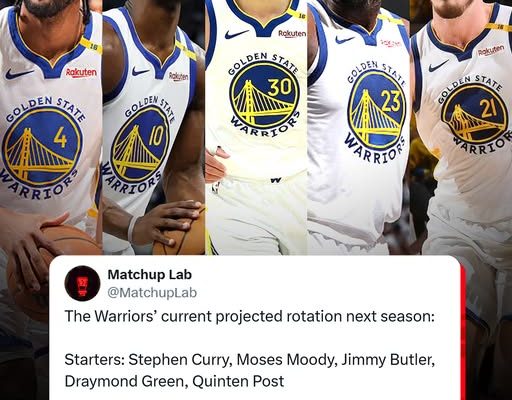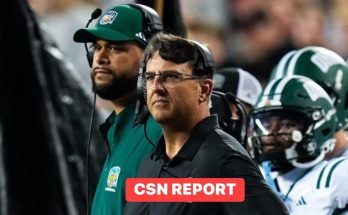The Golden State Warriors are entering a fascinating and pivotal era in franchise history—one defined by the weight of legacy and the electric potential of what’s next. As the curtain falls on the dynasty’s most dominant years, a new chapter is being written, blending championship-tested experience with a fresh injection of young talent and bold ambition. What lies ahead is not a rebuild. Nor is it a simple continuation of past glory. It’s something in between—a competitive recalibration fueled by the leadership of veterans who know what it takes to win and the hunger of new faces eager to prove they belong in the spotlight of the NBA’s most scrutinized stages.
At the heart of this evolving story is the iconic trio that shaped one of the most celebrated dynasties in league history: Stephen Curry, Klay Thompson, and Draymond Green. Though Thompson’s future briefly seemed uncertain during a difficult contract year that saw his role shift and his production fluctuate, his departure marked the end of an era—yet not the end of belief. Curry remains the face of the franchise, and his work ethic, humility, and leadership continue to set the standard for everyone in the organization. Green, meanwhile, remains the emotional engine, though questions surrounding his durability and discipline grow louder with each passing season. These pillars have etched their names into the basketball history books with four championships, but they’re not content to live in the past.
The organization has made it clear: the aim is still to contend. But doing so now will require more than nostalgia. The Western Conference is more competitive than ever, and Golden State can no longer rely solely on its veteran core to carry the load. The front office, aware of this truth, has embraced change with a series of moves designed to inject youth, athleticism, and hunger into the roster.
Perhaps the most intriguing storyline of the new era is the emergence of Jonathan Kuminga. Long hailed for his raw talent and athletic potential, Kuminga’s development has been both frustrating and tantalizing. Under the pressure of a team trying to win now, he was sometimes relegated to the bench or given inconsistent minutes, leading to questions about whether the Warriors could afford the patience his growth required. But last season, Kuminga started to turn a corner. With more freedom to attack, improved decision-making, and a growing comfort in his role, he flashed signs of being the two-way force the Warriors envisioned when they drafted him. This season, Kuminga is no longer a developmental project—he’s a critical piece in the Warriors’ plans to compete.
Moses Moody is another young Warrior whose role is poised to expand. With a reputation for professionalism, defensive versatility, and efficient spot-up shooting, Moody’s potential to carve out a consistent rotation spot could help stabilize the wing position. His ability to defend multiple positions and contribute without needing high usage makes him a perfect fit alongside Curry’s gravitational pull on offense. This season is a proving ground for Moody, who, like Kuminga, is being asked to mature quickly under championship-level expectations.
The offseason also brought in fresh faces looking to make a splash. The Warriors made savvy moves in the draft and free agency, targeting players who can contribute immediately without sacrificing long-term upside. Rookie talents, versatile defenders, and role players with playoff experience have all been brought into the fold with one mission: complement the remaining championship core while providing the burst of energy needed to compete with younger, more athletic teams in the West.
At the center of this philosophical shift is head coach Steve Kerr. Long respected for his calm demeanor and player-first approach, Kerr now faces a different kind of challenge. Gone are the days of simply rolling out the same veterans and trusting their chemistry to deliver wins. Kerr must now balance development with competitiveness, mentorship with expectation. His ability to adapt his schemes, manage egos, and create an environment where youth can flourish will be key to Golden State’s trajectory. Kerr’s championship pedigree remains an asset, but in this era, flexibility and innovation may be even more vital.
Steph Curry’s leadership remains an anchor amid all the change. At 37, he continues to perform at an elite level, his gravity on the court still unmatched. But Curry can no longer win games on his own. He needs help from those around him—not just the veterans he trusts, but also the new generation tasked with carrying the torch. His role as mentor and motivator is as important as his scoring or shot-making. The young players look to him for guidance, and his standard of excellence keeps the locker room focused.
Andrew Wiggins is another name who finds himself at a crossroads. After a breakout role during the Warriors’ 2022 title run, Wiggins saw a decline in form last season. Whether due to injury, confidence, or system fit, his contributions were inconsistent. The Warriors are betting that a reinvigorated Wiggins can return to his elite two-way form, defending the opposing team’s best wing while providing timely scoring. His ability to bounce back could be the swing factor between playoff contention and early elimination.
The Warriors’ front office also deserves credit for walking the tightrope between honoring their legacy and preparing for the future. General Manager Mike Dunleavy Jr., in his second year at the helm, has been methodical in crafting a roster that respects the team’s identity while acknowledging the evolution required to remain competitive. Moving on from key players isn’t easy, especially when those players helped define a dynasty, but Dunleavy understands the NBA doesn’t pause for sentiment.
That understanding has fueled bold decisions, including trading Jordan Poole—a once-promising young scorer whose erratic play and locker room tensions made his fit untenable—for veteran Chris Paul. Though Paul’s first season with the Warriors had its ups and downs, his presence offered a steadying force for the second unit and another voice of leadership in a locker room in transition. However, with Paul now gone, Golden State’s backcourt rotation is open again, creating opportunities for emerging talent to take the reins.
One potential X-factor is Brandin Podziemski. The young guard showed flashes of brilliance during limited minutes last season, earning praise for his high IQ, effort on both ends, and fearlessness. Podziemski’s skill set aligns with the Warriors’ motion offense—he makes quick reads, can shoot off the catch, and competes defensively despite lacking elite athleticism. If he continues to develop, he could be a surprise contributor in the rotation.
The same can be said for Trayce Jackson-Davis. The second-year big man impressed with his physicality, rim protection, and willingness to do the dirty work. With questions surrounding Kevon Looney’s longevity and the frontcourt depth in general, Jackson-Davis could be thrust into a larger role, especially if the Warriors shift toward a more defense-first identity.
All of this unfolds in a Western Conference that shows no mercy. Oklahoma City, Minnesota, Denver, and Sacramento have all improved, and teams like Phoenix and the Lakers remain formidable. Golden State won’t be granted any deference because of past rings. Every night is a battle. Every game matters. And the Warriors can no longer rely on muscle memory to will themselves to wins.
The spotlight will be unrelenting. Mistakes will be magnified. Chemistry will be tested. But Golden State is embracing this next era not with fear, but with purpose. There’s an understanding that time is precious, especially with Curry still playing at an MVP level. The veterans want one more run. The young players want to make a name for themselves. The coaches want to prove they can adapt. The front office wants to show it has a vision.



